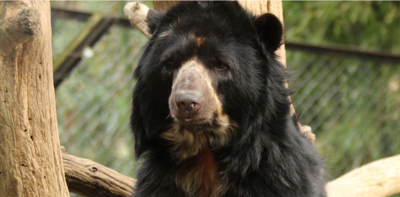SALISBURY, MD - Over a decade after he was rescued by a farmer in Ecuador, Pinocchio the Andean bear continues to capture hearts all over Delmarva. Though no longer at the Salisbury Zoo, Pinocchio’s journey is far from over - join WBOC as we take a look back on his story, as well as get a glimpse into what could be in store for the beloved bear and the Salisbury Zoo.
Pinocchio was first rescued by a farmer in Ecuador. Raised in captivity, he soon became too reliant on people for safe release back into the wild. By the time Ecuador’s Ministry of the Environment stepped in to care for him, Pinocchio had become too accustomed to humans. He was moved to the Ilito Wildlife Rescue Center at the base of the Cotopaxi Volcano in Ecuador.
“Here in our rescue center we actually focus on rehabilitation and release of wild animals, and Pinocchio is a bear we will not be able to release,” Sebastian Kohn with the Litio Wildlife Rescue Center told WBOC at the time. “He is completely imprinted. when he was a cub - the person that would take care of him would sleep even with the bear and would feed him and treat him like a baby. So that doomed the bear to not be able to be released.”
Luckily, here on Delmarva, the Salisbury Zoo was focused on protecting and preserving the Andean bear, and they had a female - Chaska. In order to keep the vulnerable species genetically viable, it was decided to move Pinocchio to Salisbury in the hopes he and Chaska could produce offspring as part of the Andean Bear Species Survival Plan.
Two now former members of the Salisbury Zoo traveled all the way to Ecuador to bring Pinocchio to Delmarva, and WBOC went with them to document the entire journey.
Pinocchio was then flown from Ecuador to Miami and made the long haul up the East Coast to the Eastern Shore of Maryland.
The mission was a success. While at the Salisbury Zoo, Pinocchio fathered a total of three cubs with Chaska: Sinchi, Inti, and Raymi. Sinchi is currently just a few hours north at the Philadelphia Zoo. Inti found a new home at the Racine Zoo in Wisconsin, and Raymi has travelled abroad to Zoo Zurich in Switzerland.
The Andean Bear Species Survival Plan determines how best to care for captive Andean bears and where they best fit, which determined where Pinocchio’s offspring would go. It would also ultimately decide where Pinocchio was headed next.
Though Pinocchio will always be Salisbury’s bear, he currently calls Tennessee home and is well cared for at the Nashville Zoo. There, it is hoped the same success the Salisbury Zoo saw with Pinocchio and Chaska can be replicated with Pinocchio and the Nashville Zoo’s female bear Luka.
“Luka has never had a successful cub at this point in her life so her genes are also super important to get out there,” Meredith Daniel with the Nashville Zoo tells WBOC. “She had been with a male for a few years and hadn’t produced a cub so the opportunity to get Pinocchio here with his genes to pair with Luka’s genes - we jumped on that opportunity.”
Whether Pinocchio will father more cubs with Luka remains to be seen, and there is no set time for him to stay at the Nashville Zoo. Because of his valuable genes, he could very well move on to another zoo that has the ability and space for Andean bears to breed. A return to Salisbury is not out of the question.
Back on Delmarva, the Salisbury Zoo is still committed to the Andean Bear Species Survival Plan - and they have big plans for the program’s future and the Zoo itself. Chuck Eicholz, the Zoo’s director, tells WBOC they are building a new exhibit, with a much bigger enclosure planned for the bears.
“We want to build something that is going to work for the animals and work for us financially,” Eicholz said. “And for the animals' welfare, care, and well being. We’ve sat down - the animal care staff - education - our guest service department - are all part of the design. so it’s not just designing for the animals - it’s designing for the guests.”
The new visitor center will be aptly named Pinnochio’s Place.
With her lineage now well-established, Chaska won’t be having any more cubs, and could possibly be moving from Salisbury as well. The new exhibit, however, will continue to play a critical role in preserving the vulnerable Andean bear population.
Pinocchio’s importance in that mission is undeniable. Where his journey takes him next is up in the air, but perhaps one day he’ll find his way back to Wicomico County. For now, we’ll just have to wait and see.
“He’s just a really great bear and we just wanted to take that and build on it,” the Nashville Zoo’s Meredith Daniel says. “So we are currently training him on a blood draw behavior and he’s almost ready for that. He puts his arm in a sleeve and we can draw blood from it. We can shave his arm. He’s also allowing voluntary injections. So he’s doing some pretty advanced behaviors because our set up we have a pretty advanced setup here that allows us to do really cool things like that. We also have a really cool scale and crate thing that he will get in voluntarily. And he just is so so smart. We absolutely love him and we are just trying to advance him further so the next place he goes or if he goes back to Salisbury he’s even got more on his plate.”
Pinocchio’s journey continues.
You can watch WBOC’s full special on Pinocchio's journey attached to this article or tune in tonight, November 27 at 7:30 p.m.!




